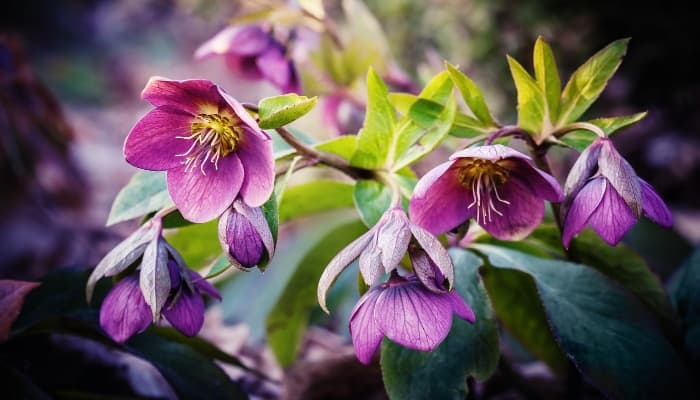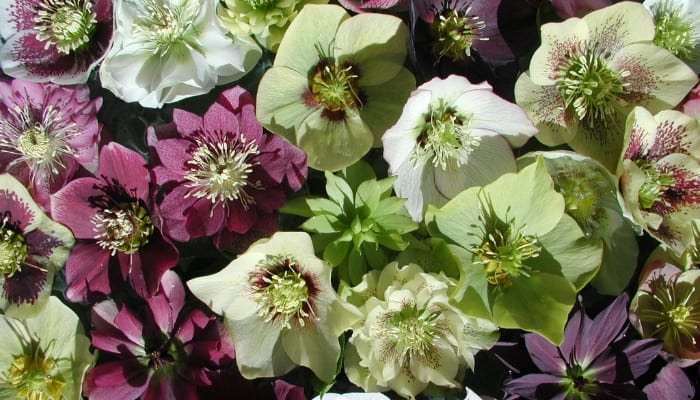You may think hellebores are a singular type of flower, but in reality, they encompass several species that fall under the Ranunculaceae family.
The Helleborus genus consists of flowers that are white, green, pink, red, or multi-colored, so there is surely a color that will compliment your landscape!
Make sure you understand how to care for one to get the most out of it during the blooming season.
When should you plant hellebores? Hellebores are best planted in the fall but can be planted anytime the ground is not frozen. They can be planted in the winter in warmer climates where the ground doesn’t freeze, but they won’t have any time to establish and may not flower during the season of planting.
For a better understanding of the Helleborus genus, requirements for growing a variety, and care after planting, continue reading!
You’ll grow beautiful hellebores if you follow all of these steps, and you’ll make all of your gardening friends jealous as well!
When To Plant Hellebore
Plant your hellebores in the fall so they can establish in the ground and bloom in the upcoming spring! They’re easy to plant and make a great gardening day activity.
You’ll find that they thrive in most locations, even the shady parts of your landscape. See more tips below to get them planted right!
Best Time To Plant Hellebore
Fall is the best time to plant hellebore seeds because they only sprout when they undergo cold stratification. Planting them in the fall allows them to overwinter, experience the cold, and then sprout in the spring.
If you purchase blooming plants in the late winter or early spring, by all means, go ahead and plant them. Just know that their peak blooming has already passed, and it will be next year before they bloom again.
Where To Plant Hellebore
Hellebores are unique because they actually do well in the shade! While most plants will only thrive in full sun and require it to sprout, hellebores will do well in partial shade or full shade.
Pick any spot you hope to fill with color where other species won’t grow at all!
Hellebore Soil Type
Choose well-draining soil to sow your seeds as plants will not perform well in heavier clay soils. The soil needs plentiful organic matter, so if your soil is barren, amend it with compost or other natural soil amendments.
Hellebore Light Requirements
Because this is a shade-loving plant, aim to place your hellebore in an area that receives shade in the summer and sun in the winter. Deep, dark shade won’t do, but a location that receives more ambient light than direct sunlight will be ideal.
How To Plant Hellebores
Hellebores are best started from seed. Follow these simple steps, and you’ll be growing in no time!
You’ll need to find an ideal planting location, amend the planting area (if necessary), place and bury the seeds, keep the soil lightly moist, and care for the seedlings as they sprout. See the detailed list below for a planting guide.
- Locate an area that receives more shade than sunlight. Corners of the garden or under other plants in the shade will offer the best opportunities to add color and give your hellebores the perfect environment.
- If the soil is extremely dense or lacks nutrients, amend the soil by adding natural compost, fertilizer, or other amendments. Dig and churn the soil 16 to 18 inches deep to make the soil favorable by adding pore space to support root development.
- Place the seeds about 1 to 2 feet apart, and then gently press them into the soil. You’ll want them to be flush with the top of the ground or only ⅛ inch below it. Any deeper and they most likely won’t sprout.
- Keep the soil lightly moist. Too much water and you’ll rot the seeds. Too little and they’ll never sprout! Allow the soil to slightly dry out between waterings. This will make the seeds “pop” as the seed coat expands and shrinks based on the moisture levels.
- Continue to monitor the seedlings. Make observations in regard to the amount of sun, soil moisture, and any pest activity.
Growing Hellebores in Pots
Hellebores grow well in pots, but ensure the pot is deep enough to allow the roots to grow at least 12 inches.
Growing hellebores in pots will require more water than if planted in the ground because there is not as much soil space with moisture to pull from.
Hellebore Care – Growing Guide
It’s easy to grow and care for hellebore, known as the Lenten rose, if you know how. Once they’re established, you’ll just need to water them, maybe pick some when they bloom, and trim them back at the end of the season!
Aim to give them about ½ inch of water per week, and keep the soil slightly moist.
They should bloom in the late spring and last through the summer months if watered adequately. A layer of mulch around the plants will help to slow moisture loss.
If you begin to notice a lack of hellebore flowers or green growth, this is a clear sign the soil is void of nutrients and probably too dry.
Amend the soil and try growing again next season for better results. Fertilizing the soil once the first leaves sprout will help give them sufficient nutrients to bloom and stay alive.
Once the blooms begin to wilt and die off, you can prune out the flower stalks or trim the whole plant back.
Should You Prune Hellebores?
Yes, pruning hellebores can be beneficial for their overall health and appearance. Proper pruning can help enhance their growth and flowering potential.
Remember that hellebores have toxic properties, so it’s a good idea to wear gloves while handling them and wash your hands afterward.
Additionally, pruning practices might vary slightly depending on the specific type of hellebore you have (e.g., Helleborus orientalis, Helleborus niger, etc.), so it’s a good idea to check for any specific care recommendations for your particular variety.
Here are some tips on pruning hellebores:
- In late winter or early spring, before new growth emerges, prune away the old, damaged, or discolored foliage from the previous year. This will help showcase the new flowers and prevent any potential diseases that might be harbored in the old leaves.
- Once the flowers have finished blooming, remove the flower stems. This not only keeps the plant looking tidy but also redirects energy into the growth of new leaves and roots rather than producing seeds.
- Deadheading involves removing spent flowers as they fade. This can encourage the plant to continue producing new flowers and extend the flowering period. It can also prevent the plant from self-seeding excessively if you want to control its spread.
- If your hellebores are getting too dense and crowded, selectively thin out some of the foliage. This will improve airflow around the plant and reduce the risk of fungal diseases.
- If your hellebores become very overgrown or start to lose vigor, you can perform a more extensive cutback. This involves trimming the entire plant back to a few inches above the ground. While this might seem drastic, hellebores are quite resilient and can rejuvenate from such pruning.

Frequently Asked Questions:
Do Hellebores Spread?
Hellebore varieties are known to self-sow. This means as they grow through the season, they will drop the seeds they produce. These will then plant themselves, sprouting in the next season.
If you have a few varieties planted near one another, you may be surprised the following season when a new color you didn’t plant appears! They will self-hybridize making new combinations year after year.
How Many Years Does It Take for Hellebores To Bloom?
Hellebores will grow and bloom the same year they are planted unless the seeds used are from a previous season. If the seeds aren’t planted right away, they will go dormant.
These dormant seeds are fully dried out, and a thick coating has formed that takes time to penetrate. In most cases, dormant seeds will take a year or more to sprout.
How Long Do Hellebores Live?
This genus of plants is perennial and will typically continue to thrive for up to 10 years in ideal conditions. Each season, the blossoms will last a month or more! They’re quite a treat and are sure to impress.
Final Thoughts About Planting and Growing Hellebore
Most people probably haven’t heard of hellebores, but they’re truly a great species to plant. Plant your hellebores in a shady area, and they’ll grow year after year with ease. This guide has everything you need to grow them well!

